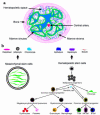The bone marrow leaves its scar: new concepts in pulmonary fibrosis
- PMID: 14722608
- PMCID: PMC311440
- DOI: 10.1172/JCI20782
The bone marrow leaves its scar: new concepts in pulmonary fibrosis
Abstract
Excess collagen deposition occurs in pulmonary fibrosis. A new study suggests that collagen overproduction may originate from cells derived from bone marrow precursors rather than parenchymal lung fibroblasts.
Figures


Comment on
-
Bone marrow-derived progenitor cells in pulmonary fibrosis.J Clin Invest. 2004 Jan;113(2):243-52. doi: 10.1172/JCI18847. J Clin Invest. 2004. PMID: 14722616 Free PMC article.
References
Publication types
MeSH terms
Substances
LinkOut - more resources
Full Text Sources
Other Literature Sources
Medical

